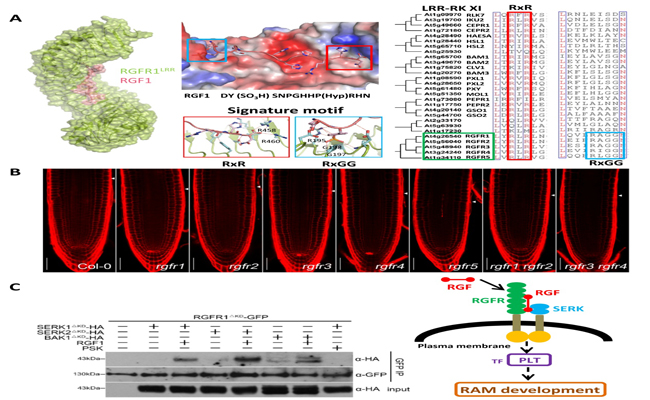Prof. Jijie Chai’s group reported the identification of plant peptide hormone receptors for root meristem growth factors
On May 27th, the research group of Prof. Jijie Chai at Tsinghua University in collaboration with Prof. Hongwei Guo’s group at Peking University published a research article entitled “Signature motif-guided identification of receptors for peptide hormones essential for root meristem growth” in Cell Research. The paper reported the findings of five receptor kinases (RKs) as the receptors of plant peptide hormone--root meristem growth factors (RGFs) and SERKs as co-receptors with these five RKs, revealing the molecular mechanism of RGF perception by their receptors (RGFRs) and providing a proof of principle for structure-based matching peptide-receptor pairs in plants.

A Discovery of RGFRs and molecular mechanism of RGFs recognition by RGFRs
B RGFRs were essential for RAM development
C RGF induced RGFR and SERK dimerization for signaling activation to regulate RAM development
Small signaling peptides in plants play essential roles in various aspects of plant growth and development. Root apical meristem (RAM), a region of the root tip consisting of undifferentiated cells, gives rise to different types of root cells, thus playing vital roles in regulating root pattern formation and adaptation to environmental stimuli. A family of secreted and tyrosine sulfated small peptides called root meristem growth factors (RGFs) is important for stem cell niche maintenance and root pattern formation by defining expression and distribution of the transcription factors PLETHORAs (PLTs). Despite the important roles of RGFs in plant development, their receptors remained unidentified.
The two groups applied a structure-based in vitro biochemical assay to identify the receptors of RGFs. Based on a signature small peptide recognition motif (RxR) conserved in a subfamily of LRR-RKs, they screened a pool of small peptides for their abilities to interact with the extracellular leucine-rich repeat (LRR) domains of RKs from this subfamily. By this assay, they identified a functionally uncharacterized RK as a receptor of RGF1 (RGFR1), which was supported by a combination of biochemical, structural and genetic evidence. Additional four RGFRs were further identified based on a second structural motif, RxGG, responsible for specific recognition of the sulfate group of RGF1 as revealed by the crystal structure of the RGF1-RGFR1 complex. They also demonstrated that SERKs function as co-receptors with RGFRs. The findings of RGFRs and SERKs as co-receptors with RGFRs provide new insight into RAM regulation and will facilitate further dissection of RGF-induced signaling pathways. Furthermore, the screening strategy described in the paper can be used to match RGF-like peptide ligands with their receptors in plants.
Wen Song (PhD student) from Tsinghua University and Li Liu (PhD student) from Peking University are co-first authors; Prof. Jijie Chai, Prof. Hongwei Guo and Dr. Zhifu Han are the corresponding authors of the paper; Jizong Wang, Zhen Wu, Heqiao Zhang, Jiao Tang and Guangzhong Lin from Tsinghua University, Yichuan Wang, Wen Xing and Wenyang Li from Peking University also participated in part of the work. This research was funded by State Key Program of National Natural Science of China and Tsinghua University-Peking University Center for Life Sciences.
The paper links: http://www.nature.com/cr/journal/v26/n6/full/cr201662a.html

